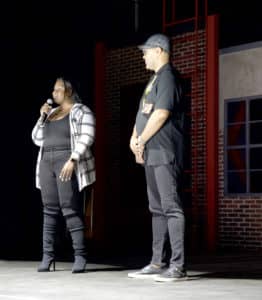Thrive
Waveney Ann Moore: Hopeful progress toward combating HIV

With signs that the coronavirus is loosening its vice-like grip on the world’s population, recent news that a third person has been cured of HIV offers another bit of relief on the health front.
It’s a glimmer of hope in the years-long battle against a virus that has acutely affected Black communities. Black Americans, the CDC says, account for a higher proportion of new HIV diagnoses and people with HIV than those of other races and ethnicities.
In Pinellas, African Americans had rates of new HIV diagnoses three times higher than whites in the county. That’s according to the Florida Department of Health, which also reports that in both 2019 and 2020, Pinellas County was the 12th highest county in the state for new HIV diagnoses.
There are efforts to remedy that.
A spokesman for the Florida Department of Health in Pinellas pointed to an initiative, Pinellas County Ending the HIV Epidemic, that set a goal to reduce new HIV cases by at least 90 percent by 2030. The partnership lists organizations such as Metro Inclusive Health, Empath Partners in Care, the Interdenominational Ministerial Alliance of St. Petersburg and the University of South Florida.

Shaundia White (left), AHF Regional Director for Central and Northern Florida, and Imara Canady, AHF National Director for Community Engagement, at the International Condom Day burlesque show.
I reached out to the AIDS Healthcare Foundation to find out about its work in the area. It’s not part of the Pinellas County Ending the HIV Epidemic effort. It has worked, though, with community groups through an initiative started by the Foundation for a Healthy St. Petersburg, said Shaundia White, AIDS Healthcare Foundation’s regional director for Central and Northern Florida.
The global foundation, which established a site in St. Petersburg five years ago, operates a clinic, pharmacy and thrift store on 34th Street S., in a mostly African-American neighborhood. The location dispenses HIV/AIDS medical care and medical case management, as well as HIV and STI testing and treatment.
Reports of what is said to be only the third HIV cure is certainly reason for hope. That the woman who was cured is of mixed race is being touted as especially promising for people of color.
There is further reason to be optimistic about what might be ahead for combating HIV. It’s a surprising one. White says the Covid-19 pandemic has made people more interested in being tested and educated about HIV and sexually transmitted infections. People seem to be just “a little bit more health conscious” and want to know more about infectious diseases, she said.
“So we’re seeing a lot more engagement from people coming to test, whether it’s at one of our sites, at one of our mobile units or even at events where we’ll provide testing,” she said.
Not only are they showing up to be tested, they’re bringing others with them to find out their status and get information about services the foundation offers.
The CDC blames the high rates of HIV among Black Americans on racism, HIV stigma, homophobia, poverty, and barriers to health care.
White called the disparities faced by Black and Brown communities as a double-edged sword.
“You know there’s a need for that education piece in the importance of preventative care, but then there’s also access to care and making sure care is readily available to everyone, whether it’s in rural areas, urban areas and especially in heavily minority communities.”
Imara Canady, the foundation’s national director of communications and community engagement, and chair of the Black Leadership AIDS Crisis Coalition, offered an additional perspective. He referred to what he called “generational trends.”
“Speaking from the lens of Black Americans, if I grew up in a household where getting physicals every year, going to the dentist – medical care and wellness – were routine, then the next generations are likely to follow. Oftentimes, generations of Black folks go to the same doctor, go to the same dentist and that kind of thing.”
But that’s not always the case.
Others might have grown up where healthcare didn’t or couldn’t come first. Maybe such basic needs as putting food on the table might have been the priority, Canady said. “So how do you shift the trajectory of sometimes what has been an absence of generational learning around the importance of health and wellness within Black communities?”
White said the foundation is interested in partnering with the Florida Department of Health to look at more innovative ways to engage the community “outside of just providing medical care.”
That would include collaborating on education, with church-based organizations, community centers “and things that are less traditional in terms of their space,” she said.
In other words, going where people are in order to see and understand their needs and challenges, whether it’s housing, mental health, substance abuse, income, job loss, all issues that can affect a person’s health.
Canady said the organization wants to change a trend prevalent in the South, including Pinellas County.
“We’ve got to be more concerted around ensuring that the epidemic and its impact on Black women is more elevated, because, unfortunately, we oftentimes see the impact of HIV on Black women, but Black women are not a part of the conversation or that impact is not a part of the equation,” he said. “We just did a program that we’re taking around the country that focused on Black women and having safe spaces and conversations.”
Attention obviously needs to remain on decreasing HIV among Black men, but, he added, “Equally, we need to make sure that we do not let our sisters not be a part of the conversation, ensuring that their health and wellness is equally taken care of and elevated.”
The organization’s attention to diversity is broad, employing an “affinity group program” that uses culturally relevant ways to connect to different communities.
Additionally, said Canady, “We’ve been very successful in terms of creating awareness around education and connecting the testing through the use of art and culture.”
One such event was held in the days before the foundation’s International Condom Day.
“It was a twist to the “West Side Story,” with a little burlesque twist to it and intertwined in the messaging. We had really fun and cute ways of talking about safe sex, condom usage,” he said. “It was in outdoor space over in Tampa and it was packed. Every strata of society was there.”







